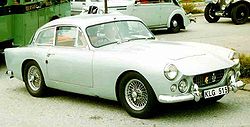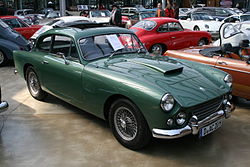AC Greyhound
| AC | |
|---|---|
|
AC Greyhound Saloon 1962
|
|
| AC Greyhound | |
| Production period: | 1959-1963 |
| Class : | Sports car |
| Body versions : | Coupe |
| Engines: |
Petrol engines : 2.0–2.6 liters (75–125 kW) |
| Length: | 4570 mm |
| Width: | 1660 mm |
| Height: | 1330 mm |
| Wheelbase : | 2540 mm |
| Empty weight : | 1070 kg |
| successor | AC 428 |
The AC Greyhound is a sports car produced by the British car manufacturer AC Cars Ltd. , which was produced in small series from 1959 to 1963.
Model history
The AC Greyhound was presented at the London Motor Show in October 1959. It was a two-door, four-seater coupe with a hatchback body that complemented the brand's previous models, the open two-seater Ace and the closed two-seater Aceca . AC used a tubular frame like the Ace and Aceca, but lengthened the wheelbase by 250 mm and built in a trailing arm axle at the rear .
The body
The body of the greyhound was designed by Alan Turner, the chief engineer of AC Cars. The design was essentially based on the lines of the Aston Martin DB4 , but was generally less elegantly proportioned. A very short, high passenger cell follows a very long bonnet. Turner's first draft still had a very wide C-pillar with tight, trimmed side windows. The rear windows were enlarged for series production, and the hatchback was given a generous panoramic window , the design of which was reminiscent of the Bristol 405 . Finally, there were clearly noticeable fins on the stern that carried the taillights. The body of the series models was made by hand from aluminum.
The motors
AC offered the Greyhound with three motors, each coupled to a manual four-speed gearbox, an overdrive was also available on request :
- First there was the Greyhound with a two-liter in-line six-cylinder engine that AC had designed itself. It delivered 75 horsepower # bhp (56 kW) at 4500 rpm and was generally described as sluggish. Few customers ordered it.
- There was also a two-liter six-cylinder engine from competitor Bristol Cars Ltd. available. This was based on a BMW design and at that time Bristol was no longer offering it for its own models: the two-liter engine known as the T 102 was last used in the Bristol 405, production of which had ceased in 1958. The contemporary Bristol model, the 406 , instead received a 2.2 liter version of the engine called the T110. The AC's two-liter engine developed 105 bhp (78 kW) at 4700 rpm, but was much more revving and more powerful than AC's own engine. Most greyhounds were fitted with the Bristol two-liter engine. A few copies are said to have been delivered with the 2.2 liter Bristol T 110 engine; this made 125 bhp (93 kW). Bristol switched to American Chrysler engines in 1961 with the Model 407 . Regardless of this, the company initially continued to deliver its own six-cylinder to AC; in the summer of 1962, however, production of the engine was finally stopped.
- As a replacement for the Bristol engine, AC purchased a 2.6 liter six-cylinder engine from the British Ford subsidiary for the last year of production , which had been designed for the Zephyr sedan . Although he made 170 bhp (127 kW), but was phlegmatic and changed the weight distribution of the Greyhound disadvantageously due to its mass. Only a few greyhounds were equipped with it.
The production
AC produced a total of 82 copies (plus a prototype) between 1959 and 1963. In addition to its not very attractive appearance, the main reason for the low distribution of the car was its high price: The Greyhound was half more expensive than a Jaguar XK 150, which in turn was almost twice as powerful as the Jaguar XK 150 with 190 bhp (142 kW) AC and - in the opinion of most observers - also looked much better.
AC stopped production in the summer of 1963 when the company had to realize that the available engines could not compete seriously with the Aston Martin or the Bristol equipped with American engines. AC initially tried to find other engines for the greyhound - this included the eight-cylinder from Daimler and the small aluminum eight-cylinder from Buick , which was taken over by Rover a short time later - but ultimately nothing came of it. The company had realized that the little Cobras , which were made for Carroll Shelby at the same time and were based on the ACE Ace chassis, could earn a lot more than the Greyhound.
An indirect successor to the Greyhound was the AC 428 . 81 of these were produced between 1965 and 1973. AC used an extended Cobra chassis with a large American eight-cylinder engine and an Italian body from Frua .
Competitors
literature
- Greyhound , in: OLDTIMER MARKT special issue "Luxury performance and four seats - Gran Turismo: The big travel coupés", special issue 14, 2004.
- From the best source : Driving report and purchase advice for the Greyhound and comparison with Talbot Lago T14 in: Motor Klassik , issue 10/2009.


